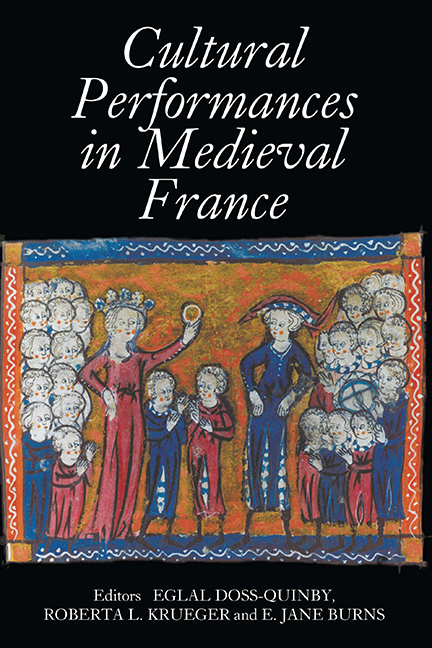Book contents
- Frontmatter
- Contents
- List of Illustrations
- Contributors
- Introduction
- Nancy Freeman Regalado, Curriculum Vitae
- PART I POETIC AND MUSICAL PERFORMANCES
- PART II PERFORMING SEXUAL AND SOCIAL IDENTITIES
- PART III DEVOTIONAL PRACTICE AND TEXTUAL PERFORMANCE
- Performing Vernacular Song in Monastic Culture: The lectio divina in Gautier de Coinci's Miracles de Nostre Dame
- Performative Reading: Experiencing through the Poet's Body in Guillaume de Digulleville's Pèlerinage de Jhesucrist
- The Anglo-Norman Office of the Cross in the Lichtenthal Psalter
- “Laver de ses pechiés une pecheresse royale”: Psalm Collects in an Early Fourteenth-Century Devotional Book
- PART IV PERSUASIVE PERFORMANCES
- PART V RE–ENACTMENTS AND LEGACIES
- Tabula Gratulatoria
- Tabula Gratulatoria
The Anglo-Norman Office of the Cross in the Lichtenthal Psalter
from PART III - DEVOTIONAL PRACTICE AND TEXTUAL PERFORMANCE
Published online by Cambridge University Press: 24 October 2017
- Frontmatter
- Contents
- List of Illustrations
- Contributors
- Introduction
- Nancy Freeman Regalado, Curriculum Vitae
- PART I POETIC AND MUSICAL PERFORMANCES
- PART II PERFORMING SEXUAL AND SOCIAL IDENTITIES
- PART III DEVOTIONAL PRACTICE AND TEXTUAL PERFORMANCE
- Performing Vernacular Song in Monastic Culture: The lectio divina in Gautier de Coinci's Miracles de Nostre Dame
- Performative Reading: Experiencing through the Poet's Body in Guillaume de Digulleville's Pèlerinage de Jhesucrist
- The Anglo-Norman Office of the Cross in the Lichtenthal Psalter
- “Laver de ses pechiés une pecheresse royale”: Psalm Collects in an Early Fourteenth-Century Devotional Book
- PART IV PERSUASIVE PERFORMANCES
- PART V RE–ENACTMENTS AND LEGACIES
- Tabula Gratulatoria
- Tabula Gratulatoria
Summary
Among the finest illuminated manuscripts produced in England during the second half of the fourteenth century for the noble Bohun family is a psalter now at Lichtenthal Abbey in Baden-Baden. The volume was probably made for Mary, heiress of Humphrey de Bohun, earl of Hereford, Essex, and Northampton, shortly after her marriage to Henry of Bolingbroke (later Henry IV) in 1380/1 and certainly before her death in 1394 at the age of twenty-four. It is also probable that one of Mary's daughters, Blanche, inherited the psalter and brought it with her to Germany when she married Ludwig, count-palatine of the Rhine, in 1402. By the beginning of the sixteenth century the psalter was in the possession of the abbess of the Cistercian convent of Lichtenthal, and there it has remained, except for a short period during the nineteenth and twentieth centuries.
The Lichtenthal Psalter is richly illustrated. Twelve historiated initials and borders or bas de page scenes at the main text divisions include seventy-nine Old Testament subjects, from Creation to the raising of the Brazen Serpent, twentyone of them on the Beatus page alone. The work of the artist, John de Teye, sparkles with variegated color and pattern, and tooled gold, all concentrated or compacted in extremely small areas, since the page size is only about 7 x 5 inches and the historiated initials are not more than 1.5 inches in height. Characteristic of English manuscript illumination of the second half of the fourteenth century, vivacity of gesture, active movement, and abundance of surface detail override the construction of figural substance or spatial illusion.
At the end of the Lichtenthal Psalter is an illustrated devotional text known as the Short Office of the Cross, here in Anglo-Norman instead of the normal Latin, followed by a common Latin prayer to the Virgin and Saint John, which begins “O beata et intemerata.” Ordinarily a component of books of hours rather than psalters, in its normal Latin form the Short Office of the Cross consists of a quatrain (sometimes identified as an “antiphon”) on an event of the Passion of Christ, a response, and a prayer for each of the canonical hours, Lauds excepted. Unlike longer offices, such as the Hours of the Virgin or the Hours of the Passion, there are no Psalms or lessons.
- Type
- Chapter
- Information
- Cultural Performances in Medieval FranceEssays in Honor of Nancy Freeman Regalado, pp. 153 - 162Publisher: Boydell & BrewerPrint publication year: 2007

